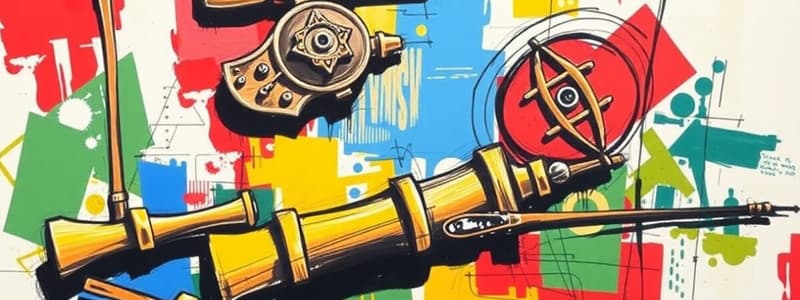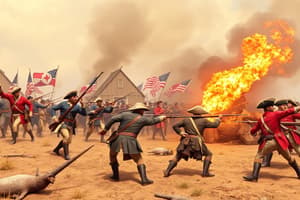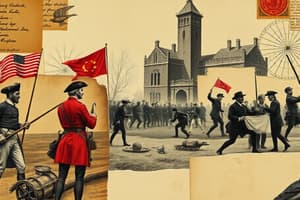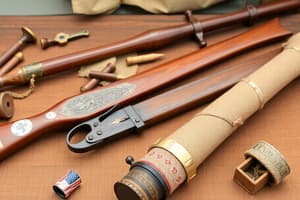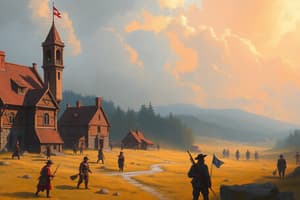Podcast
Questions and Answers
What roles did women play in supporting soldiers during the Revolutionary War?
What roles did women play in supporting soldiers during the Revolutionary War?
- Delivering messages and intelligence
- Leading troops in battle
- Collecting funds for war supplies
- Cooking, household chores, and medical care (correct)
Who was the Swiss artist associated with Revolutionary War sketches mentioned in the content?
Who was the Swiss artist associated with Revolutionary War sketches mentioned in the content?
- Hernstadt
- Skic
- Pierre Eugene du Simitiere (correct)
- Benjamin Franklin
What was the significance of the sketch donated to the museum?
What was the significance of the sketch donated to the museum?
- It visualized the daily operations of the Continental Army. (correct)
- It provided insight into the strategic plans of the Revolutionary War.
- It highlighted the roles of foreign nations in the war.
- It illustrated the battles fought during the Revolutionary War.
When was the sketch first put on public display?
When was the sketch first put on public display?
What aspect of women's contributions during the war is highlighted in the content?
What aspect of women's contributions during the war is highlighted in the content?
What was the profession of Matthew Skic?
What was the profession of Matthew Skic?
What did Judith Hernstadt primarily collect?
What did Judith Hernstadt primarily collect?
Which army's soldiers were depicted in Hernstadt's sketch?
Which army's soldiers were depicted in Hernstadt's sketch?
What did Skic find significant about the sketch?
What did Skic find significant about the sketch?
What contributed to Hernstadt's realization of the sketch's historical significance?
What contributed to Hernstadt's realization of the sketch's historical significance?
Which description was found on the back of the sketch?
Which description was found on the back of the sketch?
What event does the sketch correlate with, based on Skic's findings?
What event does the sketch correlate with, based on Skic's findings?
How many known artworks feature female followers of the Continental Army, as per the information provided?
How many known artworks feature female followers of the Continental Army, as per the information provided?
Flashcards
Revolutionary War Women
Revolutionary War Women
Women who provided essential support to soldiers during the Revolutionary War, often ignored in historical narratives.
Continental Army Sketch
Continental Army Sketch
A drawing by Pierre Eugene du Simitiere depicting the daily life and operations of the Continental Army during the Revolutionary War.
Pierre Eugene du Simitiere
Pierre Eugene du Simitiere
Pierre Eugene du Simitiere, a Swiss artist who arrived in Philadelphia in 1774 and is known for his Revolutionary War sketches.
Donation
Donation
Signup and view all the flashcards
Attribution
Attribution
Signup and view all the flashcards
Revolutionary War Sketch
Revolutionary War Sketch
Signup and view all the flashcards
Judith Hernstadt
Judith Hernstadt
Signup and view all the flashcards
Matthew Skic
Matthew Skic
Signup and view all the flashcards
Continental Army
Continental Army
Signup and view all the flashcards
Continental Army Shirt
Continental Army Shirt
Signup and view all the flashcards
North Carolina Army March
North Carolina Army March
Signup and view all the flashcards
Battle of Brandywine
Battle of Brandywine
Signup and view all the flashcards
Eyewitness Sketch
Eyewitness Sketch
Signup and view all the flashcards
Study Notes
Revolutionary War Sketch Discovery
- Judith Hernstadt, an 18th-century artifact collector, purchased a sketch depicting a Revolutionary War scene in the mid-1970s.
- The drawing shows two women, a baby, and six soldiers (2 in wagon, 2 on horseback, 2 on foot), in a horse-drawn supply wagon.
- It also included five preliminary sketches of two men.
- The sketch's significance wasn't recognized until 2023.
Discovery and Analysis
- Matthew Skic, a curator, recognized a Continental Army soldier's uniform in the drawing.
- Skic's examination confirmed the paper and ink were from the Revolutionary era.
- The sketch contained partially legible text, "An exact representation of a waggon belonging to the North Carolina Brigade of continental troops which passed through Philadelphia in August done by…". The name of the artist was missing.
- Skic traced the text to a newspaper archive describing the North Carolina brigade's passage through Philadelphia in August 1777. This march preceded the Battle of Brandywine (September 11, 1777).
- This established the sketch as an eyewitness account of the North Carolina troops.
Uniqueness and Importance
- The sketch is the first known wartime eyewitness drawing of the North Carolina troops.
- It is one of only two known artworks featuring women accompanying the Continental Army.
- Women played significant support roles (e.g., cooking, household chores, medical care) for the army, which often go unacknowledged in historical records.
Identification of the Artist
- Skic identified the likely artist as Pierre Eugene du Simitiere, a Swiss artist known for Revolutionary War sketches, who arrived in Philadelphia in 1774.
Donation and Public Display
- Hernstadt generously donated the sketch to the Philadelphia Museum of the American Revolution.
- It was put on display in April 2024.
- The sketch is considered crucial to understanding the everyday life of Continental Army troops.
Studying That Suits You
Use AI to generate personalized quizzes and flashcards to suit your learning preferences.
Description
Explore the fascinating discovery of an 18th-century sketch depicting a Revolutionary War scene. This quiz delves into the details surrounding the artifact's purchase, its significance, and the curator's analysis that linked it to the Continental Army. Test your knowledge of this historical moment and the artifacts from that era.
